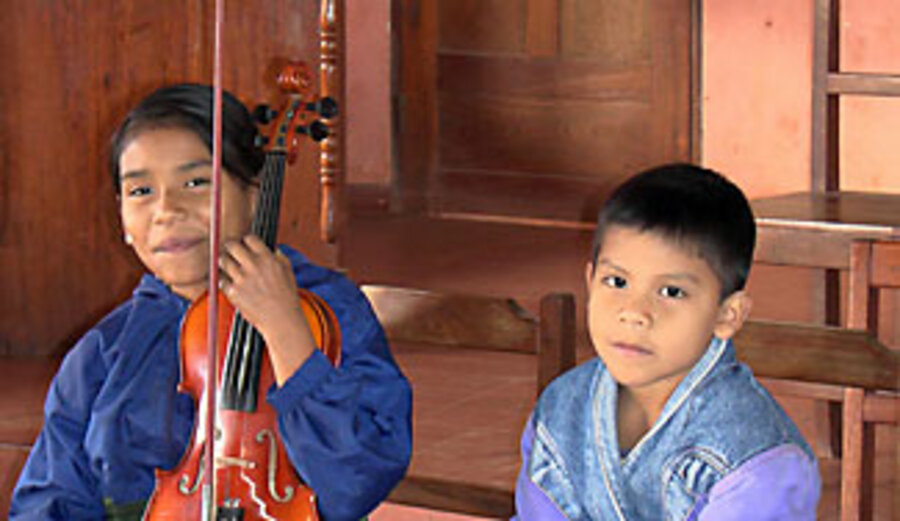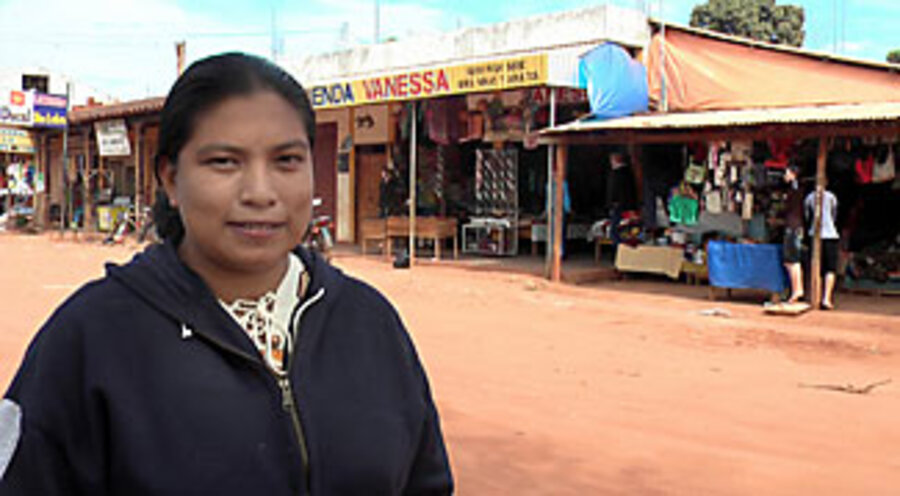Music transforms kids and towns in remote area of Bolivia
Loading...
| San Ignacio de Velasco, Bolivia
Life moves slowly in this town deep in the jungle of Bolivia, 280 miles from the nearest city, where most streets are swaths of red earth, money is made off the land, and TV, for those who own one, is not an after-dinner ritual.
It is not the kind of place one would normally seek out high culture.
But on a recent evening, off the neatly manicured central plaza, the sonatas of Vivaldi and Haydn pour from the town's imposing cathedral. Even more unusual is who is crowding many of the pews: sneaker-clad youths. They are not here under the duress of some imperious teacher. They're eagerly absorbing the sounds of string and wind instruments redounding through the wood-beamed church.
Their rapt attention is one of the most visible legacies of the International Festival of Renaissance and American Baroque Music, which may be leaving as big a mark on the small towns of eastern Bolivia as anything since the Jesuit missionaries 300 years ago. Perhaps in few places on earth is music transforming the lives of a new generation more than in this remote low-land section of South America.
The biennial baroque festival, which wrapped up last week, draws artists from across the globe who perform a repertoire of classical music that always includes at least one piece from the impressive, sacred archive, begun by the missionaries in the 17th century. The festival also attracts well-heeled tourists from Argentina, Chile, the US, and Europe.
But, more important, it has spurred many of the region's kids to gravitate toward the world of Bach and bass clefs. In recent years, some 2,500 youths from area towns, many of them indigenous, have enrolled in music schools, choruses, and orchestras. Some orchestras are fledgling, set up in church basements with members who still can't read notes. Others have begun to produce first-rate musicians.
Music has brought a sense of hope and revival here the way sports do in inner-city America. While American kids might dream of being the next LeBron James, here it is Boccherini and the anonymous 17th century composers who touched the lives of their ancestors.
"There has been a boom in orchestras in all of these mission towns," says Father Andreas Holl, a Franciscan priest originally from Austria whose church in San Ignacio de Velasco started a 35-member chorus for the community's neediest children last year. "It's not just to pass the time, it is to fill them with something more. If we teach them to be mechanics, they can learn to be good mechanics. But music teaches them to express themselves, and perhaps that way, they learn to be nonviolent."
• • •
On a Thursday afternoon, Adelina Anori Cunanguira rushes to rehearsal with the children's orchestra she conducts, ahead of their performance in the festival. The kids, who range in age from 7 to late teens, run through the church grounds in sandals, their instruments dangling at their sides. But as Ms. Anori Cunanguira directs them through a piece by Italian composer G.B. Bassani, recovered from the archives in the nearby town of Santa Ana, they settle down. "Don't forget to be here at 1 p.m. tomorrow," she reminds them after practice. "I want you to concentrate, and look at the director. Good luck."
Anori Cunanguira epitomizes the success that music has brought to the mission towns. A demure woman in her late 20s, she comes from the indigenous town of Urubicha, where a music school was set up in the mid-1990s as the Chiquitos Missions Festival, as the baroque event is known, was born.
She had never studied music, but her father played the guitar and trumpet. Yet all her friends were joining, and, like any 16-year-old, she didn't want to miss out. Since then, she has mastered the clarinet and violin, and today sings in a professional choir. She travels the world, playing in concerts and recording CDs.
Music has not only changed her life – three of her 12 siblings also play professionally today – but that of her entire town. The music institute in Urubicha has received worldwide recognition. "No one even knew there was a town called Urubicha," she says. "What we were given allowed us to transform."
Now she feels a duty to help other kids in remote towns lift their lives through voice and Vivaldi. "Our ancestors played with the Jesuits," she says. "It is in our blood." When the Jesuits arrived in this area of the country, they brought their rich musical traditions, quickly setting up choirs of professional musicians in each mission. But when the priests were expelled in the mid-1700s, and economic decline followed, the towns were nearly forgotten. So, too, was their music.
At the time Lizardo Paraba was growing up on a cattle farm in Cotoca, an hour's drive down a washboard road from San Ignacio de Velasco, no music classes existed in school. Only the elderly played the flute, occasionally. Lizardo, a skinny teen wearing jeans and a baseball cap, never even thought about music, he says, until he saw the Chiquitos Missions Festival in 2004. "I wanted to play right away," says the 15-year-old, who signed up for violin classes as soon as the orchestra in his town was formed seven months ago. He has since learned how to read music and plays in the orchestra with two younger brothers and a cousin.
• • •
For all its remoteness, San Ignacio de Velasco has its charms. True, most of the roads are dirt, and iPods and the Internet are largely notional. But the town does exude a quaintness with its red tiled-roof shops. People seem happy, and a veneer of wealth exists – some of it tied to tourism surrounding the festival.
The musical conclave came together through a confluence of events in 1996, enabled by the diligent work of musicologists transcribing the ancient works of the missionaries. At the time, the region didn't have an organ or harpsichord, or professional musicians to perform. In its first year, 12 groups played in three towns. This year 22 countries participated, including 300 foreigners and 600 Bolivians, across 20 towns.
But Cecilia Kenning, the festival president, says the primary focus has always been the children. The first music school was established in Urubicha, where residents still speak the indigenous Guarayo language, and the model has since spread to towns across the eastern lowlands. They're run by schools, towns, and local parishes, funded by a patchwork of private donations.
"This works very well in small towns, where there is no television," says Piotr Nawrot, a Polish missionary who has dedicated his life to transcribing the 12,000 manuscripts from the missions that include operas, instrumental music, sonatas, and full symphonies. "A violin comes in and it's very attractive."
Now students have a whole crop of role models, such as Anori Cunanguira. "I would love to be professional," says Juan Antiare, who sings bass in a choir called "peace and wellness" at a parish run by Father Holl. Some of his friends at school make fun of him, saying baroque music "puts them to sleep." But he seems unfazed. "Becoming professional now is much more possible with the attention of the festival," he says.
Music is changing more than the local teens. Some politicians now run for office promising to start new choirs. Adults, too, feel swept up in the fervor. Aida Vaca Diez, a local grandmother, finds the changes in San Ignacio de Velasco so dramatic they're hard to articulate. Her only regret is that orchestras don't accept children as young as 4 so she could sign up her grandson.
"Music touches the heart," she says. "You feel like you are in heaven when you listen to it."






